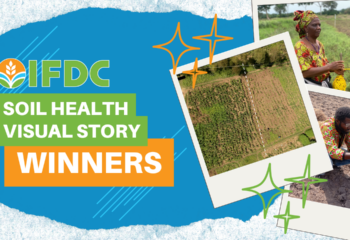
In honor of World Soil Day 2020, we asked our Senior Scientist – Systems Agronomist, Dr. Sampson Agyin-Birikorang, some questions on soil health and biodiversity. To read more about IFDC’s work in soil health, check out the Feed the Future Soil Fertility Technology Adoption, Policy Reform and Knowledge Management Project.
Q. Why is soil health, especially biodiversity, important?
A. The health of soils is dependent on the living organisms they contain, including bacteria, fungi, protozoa, insects, worms, and other invertebrates and vertebrates. A healthy soil should contain a large number and variety of organisms that interact to provide a wide variety of ecosystem services. Globally, soil biodiversity has been estimated to contribute between $1.5 and $13 trillion annually to the value of ecosystem services. Yet despite its global importance, soil biodiversity is often neglected in public policy and is being lost at a considerable rate through unsustainable land management practices, soil erosion, and other land degradation processes.
Q. What are some of the benefits of soil health and biodiversity?
A. Good soil health means sustainable agricultural output, and increasing biodiversity will increase the resilience of the soil to environmental challenges. Soil organisms control plant pests and diseases, while natural enemies and predators keep pathogen populations in check. Additionally, organisms in the soil decompose organic matter, which makes nutrients available for plant growth, and they improve soil structure (generation of pores by earthworms, incorporation of organic matter into deeper layers, enmeshing and binding of soil particles by fungi, gluing particles together by bacterial polysaccharides). These organisms improve plant growth and nutrition. Mycorrhizal fungi are more efficient at accessing soil phosphorus (P) than roots, and growth-promoting rhizobacteria access micronutrients. Furthermore, these organisms sequester carbon, which is important in maintaining soil organic matter levels and mitigating climate change. Finally, soil organisms detoxify contaminants: microbial activity can breakdown toxic chemicals and reduce organic contamination leaching to water sources.
Q. Why are healthy, biodiverse soils crucial for human health and well-being?
A. Biodiversity plays a key role in controlling populations of pathogens. Healthy, well-covered soils can reduce disease outbreaks, and carbon-rich soils may also reduce outbreaks of human and animal parasites. Soils have provided many of our current antibiotics, and exposure to soil microbes can reduce allergies. These soil microbes can also enhance crop and plant resilience. Biological disease and pest control agents are provided by soil organisms. Healthy soils mean healthier and more abundant foods. They promote good, clean air quality and are less prone to wind and water erosion; healthy soils provide clean and safe water through filtration, decontamination by microbes, and removal of pollutants.
Q. What is the effect of fertilizers on soil health and biodiversity?
A. Proper and judicious application of balanced fertilizers based on the 4R Nutrient Stewardship practices (Right fertilizer source, applied at Right rate, Right time and Right place) have a positive effect on soil health and biodiversity. Generally, fertilizers have a tremendously positive impact on agricultural productivity, food security, reduced soil degradation, and nutrient mining. However, overapplication and “rampant” use of fertilizers, particularly N fertilizers, on cropland to enhance aboveground net primary productivity can significantly alter both plant and soil biotic communities, reducing their diversity and ultimately changing the food web structure and ecological functions. Integrated soil fertility management (ISFM) practices (i.e., a combination of balanced inorganic fertilization and organic fertilizers) boosting soil health by promoting soil microbial biomass, activity, and diversity, and ultimately enhancing crop growth and production. Organic fertilizer applications that boost soil fertility and crop production are expected to enhance soil biodiversity, making ecosystems more resilient to stress. Soil chemical and microbiological properties are changed by long-term chemical fertilizers that limit ecosystem functioning.
Q. What tools and frameworks can assist farmers in regenerating soil health and biodiversity?
A. To keep soils healthy, land needs to be managed within its capability. Land management practices to increase levels of organic matter in soils and its biodiversity need to be encouraged. Strategic crop rotation increases the quantity and quality of organic matter available to soil organisms and develops a stable environment that encourages more soil biodiversity. Grazing systems that encourage plant diversity usually have higher soil biodiversity, due to the greater availability of food resources from roots and manure, which supports a greater variety of organisms in the soil. A mix of agricultural and natural ecosystems is necessary for regenerating soil health and biodiversity.
Q. What are some examples of land management practices that increase organic matter and biodiversity in soils?
A. Management practices include using minimum tillage or no-till practices to maintain groundcover and improve soil structure, maintaining and increasing perennial plants (including pasture cropping), ISFM, and judicious use of fertilizers based on 4R Nutrient Stewardship. Other good management practices involve the judicious application of pesticides and herbicides, rehabilitation of soil through targeted earthworks, water management and seeding, intercropping, sequential cropping, agroforestry, and the diversification of land use.
Q. What research and implementation are still needed to increase soil health in IFDC’s target regions?
A. The development of smart fertilizers that are climate-responsive, enhance climate resilience, require one-time application, have high nitrogen (N) use efficiency, and reduce reactive N and P additions to the environment is one of the major activities needed to increase soil health.
For example, the development of fertilizers that utilize soil’s ecosystem services is needed to continue the positive impact on food production while reducing environmental pollution. Achieving synchrony between nutrient supply and crop demand requires improved fertilizer use efficiency and fertilizer management. We also need to develop fertilizers that improve soil health, create/promote more productive and sustainable cropping systems by harnessing (and identifying) the soil microbiome’s capability to produce and/or release nutrients, increase nutrient bioavailability, and improve plant resilience to environmental stress and disease. And we will need to focus not only on fertilizers. We must continue to assist farmers to practice strategic conservation agriculture by incorporating locally available soil amendments. We need research and implementation incorporating soil biota explicitly into ecosystem process models and determining site-specific management options to promote soil biodiversity to support the development of better land-use management. Finally, no tool or practice can have true impact without national support; therefore, policy frameworks that facilitate the implementation of soil biodiversity in crop production and soil management practices are needed. The continued development of new tools and techniques provides great opportunities for new discoveries and further insights.



